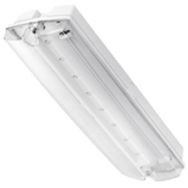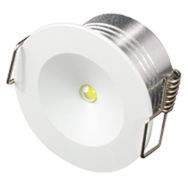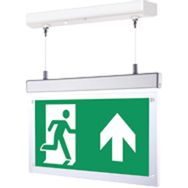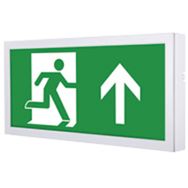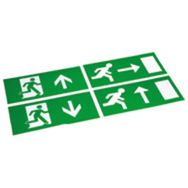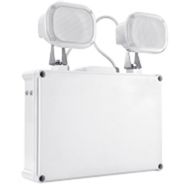Emergency Lighting
Discover our extensive range of emergency lighting at YESSS. We source our emergency lighting products from leading brands such as Luxna and ML Accessories, offering a variety of emergency LED lighting and emergency exit boxes, drop lights, downlights and bulkheads to ensure that your home or commercial building is effectively illuminated in the event of an emergency.
Shop emergency lighting today and get free UK delivery on orders over £50 (excluding VAT).
FAQs for emergency lighting products
Why is emergency lighting important?
Emergency lighting is designed to provide emergency light when normal lighting fails in the event of a mains power failure, power cut or other emergencies. They play a crucial role in guiding people to exits, highlighting escape routes and minimising panic during emergencies.
During emergencies such as fire, power outage, or natural disasters, regular lighting systems may fail, leaving people in complete darkness. In such situations, emergency lighting acts as a reliable backup system that enables safe evacuation and prevents panic. It also helps emergency responders to navigate through buildings quickly and efficiently.
What type of emergency lighting do you supply?
Here's a quick rundown of the range of emergency lighting we stock here at YESSS:
Emergency bulkheads
Wall or ceiling-mounted lights that provide general illumination during emergencies and in fire safety situations.
Emergency downlights
Recessed lights that illuminate escape routes and critical areas of your premises in case of a power outage, when the normal lighting supply has failed.
Emergency droplights
Suspended lights that offer temporary lighting during maintenance or emergency situations.
Emergency exit boxes
Illuminated boxes that highlight emergency exit doors.
Emergency exit sign
Signs with built-in lighting that indicate escape routes and exit points.
Emergency twinspot
Adjustable dual-head lights that provide high-intensity illumination during emergencies.
Emergency lighting accessories
Additional components such as batteries, test switches, and mounting kits.
Are there any safety standards I should be aware of when purchasing emergency lighting products?
Emergency lighting products must be fitted, tested and operated in accordance with local regulations and safety standards, such as BS 5266-1 in the UK.
These standards outline the minimum requirements for emergency lighting systems, including installation, maintenance and testing procedures.
Always check your local regulations before purchasing and installing emergency lighting products.
How long do emergency lighting products last during a power outage?
Emergency lighting products are typically designed to provide illumination for a minimum of 90 minutes during a power outage, as per most regulatory requirements. However, some products may offer extended durations depending on their specifications and backup battery capacity.
What is the difference between maintained and non-maintained emergency lighting?
Maintained emergency lighting operates continuously, even when the main power supply is functioning, making it ideal for areas such as theatres and care homes. Non-maintained emergency lighting only activates during a mains power failure, ensuring visibility in escape routes and other essential areas.
Why is emergency lighting a legal requirement?
Emergency lighting is required under the Regulatory Reform (Fire Safety) Order to ensure safe evacuation in non-domestic premises, including workplaces, hospitals, and commercial buildings. It must comply with European standards and provide sufficient illumination for exit routes during an emergency.
What types of emergency lighting applications are there?
Emergency lighting applications include exit signs, recessed lights, wall-mounted units and ceiling-mounted luminaires. These solutions are designed to guide occupants in both indoor and outdoor settings during emergencies, ensuring compliance and safety.
How does emergency lighting operate during a power cut?
In the event of a mains power failure, emergency lighting operates using a battery supply. This ensures that essential areas, such as escape routes and exit points, remain illuminated for a minimum duration, typically at least three hours.
Where should emergency lighting be installed?
Emergency lighting should be installed in areas that require safe evacuation, such as stairwells, corridors, exits, and high-risk areas. Wall-mounted or ceiling-mounted units are commonly used to provide visible guidance and comply with best practices.
Who is the responsible person for emergency lighting maintenance?
In non-domestic premises, the responsible person (often the building manager or employer) is tasked with ensuring the emergency lighting systems are installed, tested, and maintained in accordance with legal requirements and European standards.
What is the purpose of emergency LED lighting?
Emergency LED lighting is a modern, energy-efficient solution for providing sufficient illumination during emergencies. LED units offer longer battery life, reduced maintenance, and reliable operation compared to traditional lighting options.
How often should emergency lighting be tested?
Emergency lighting should undergo regular testing to ensure it functions correctly in an emergency situation. A monthly quick test and an annual full test of the batteries and unit are recommended to meet compliance and ensure readiness.
Is emergency lighting required for sleeping accommodation?
Yes, sleeping accommodation, such as care homes, hotels, and hostels, must have emergency lighting to guide occupants safely in the event of a fire or mains power failure. This helps ensure a safe evacuation for all occupants.
Can emergency lighting be used for outdoor applications?
Yes, outdoor emergency lighting is vital for illuminating external escape routes and exits. These units must be durable and weather-resistant to perform effectively in outdoor conditions.
How long does emergency lighting need to remain illuminated?
Emergency lighting must remain illuminated for a minimum duration of three hours, as required by fire safety regulations. This ensures that occupants have sufficient time to evacuate the premises safely during an emergency.
What should I do if my emergency lighting fails to operate?
If your emergency lighting fails to operate, contact a qualified electrician to carry out testing and repairs immediately. Regular maintenance is essential to ensure the system is functional and compliant with safety regulations.
Can I install emergency lighting in a commercial office myself?
While it is possible to install emergency lighting yourself, it is highly recommended to hire a professional electrician to ensure proper installation, compliance with legal requirements, and optimal performance in the event of an emergency.
Where can I find guidance on emergency lighting systems?
You can refer to official guidance documents, such as the Regulatory Reform (Fire Safety) Order, or consult with a professional to ensure your premises meet safety standards. Alternatively, explore the emergency lighting solutions available on YESSS Electrical’s website.
Shop emergency lighting online for fast delivery or visit your nearest YESSS Electrical store to shop in person.


